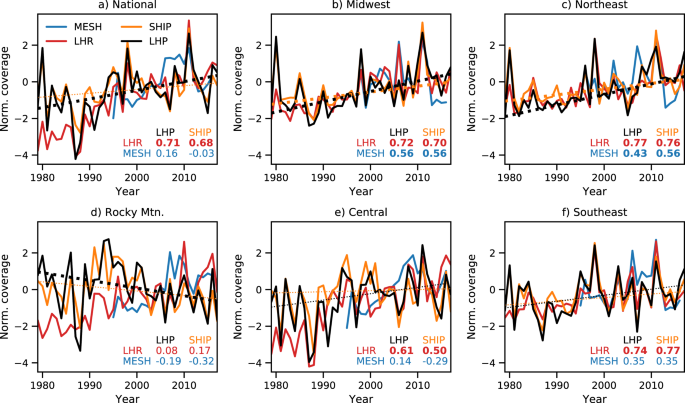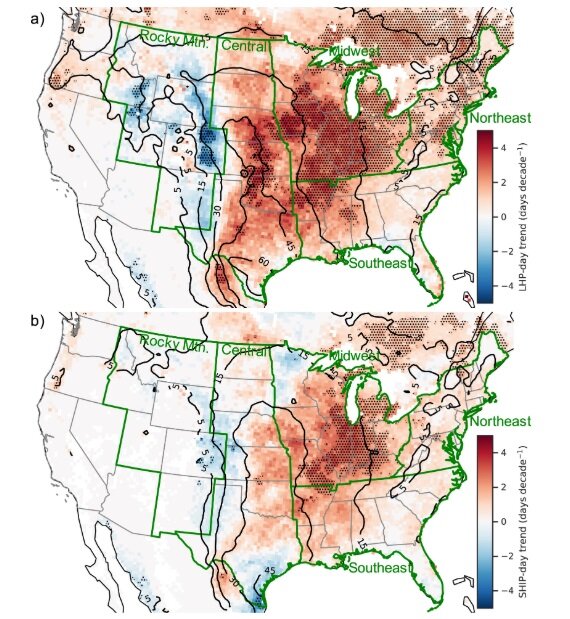Newly Identified Jet-Stream Pattern May Imperil Global Food Supplieshttps://phys.org/news/2019-12-large-atmospheric-jet-stream-global.htmlScientists have identified systematic meanders in the globe-circling northern jet stream that have caused simultaneous crop-damaging heat waves in widely separated breadbasket regions-a previously unquantified threat to global food production that, they say, could worsen with global warming. The research shows that certain kinds of waves in the atmospheric circulation can become amplified and then lock in place for extended periods, triggering the concurrent heat waves. Affected parts of North America, Europe and Asia together produce a quarter of the world food supply. The study appears this week in the journal
Nature Climate Change.
... Combing through large amounts of climate data from 1979 to 2018, Kornhuber and colleagues zeroed in on two Rossby waves with specific wavelengths, termed wave-5 and wave-7; that is, north-south wobbles in the jet stream that produce either 5 or 7 peaks and corresponding troughs around the planet's circumference. They found that while waves of lower or higher lengths seem to wobble around randomly, wave-5 and wave-7 patterns can lock into a grid of symmetric, often much larger meanders centered over predictable regions. The wave-5 patterns tend to hover over central North America, eastern Europe and eastern Asia; the wave-7 patterns over western-central North America, western Europe and western Asia. In both cases, the results are the same: hot air swirls up from the south into the peaks, producing abnormal spikes in temperature that can go on for weeks. This in turn reduces rainfall, dries up soils and vegetation, and kills crops in each region.
"Normally, low harvests in one region are expected to be balanced out by good harvests elsewhere," said study coauthor Dim Coumou of the Institute for Environmental Studies at VU University Amsterdam, who has been studying Rossby waves for years. "These waves can cause reduced harvests in several important breadbaskets simultaneously, creating risks for global food production."
... "We found a 20-fold increase in the risk of simultaneous heat waves in major crop-producing regions when these global-scale wind patterns are in place," ... "Until now, this was an underexplored vulnerability in the food system. During these events there actually is a global structure in the otherwise quite chaotic circulation. The bell can ring in multiple regions at once."
 Researchers have identified two wavelengths of meanders in the northern hemisphere jet stream that can cause massive heat waves across several major agricultural regions at once. Here, a wave-7 pattern, which over the past 40 years has hurt crop yields in the red-marked areas of central/west North America, western Europe and western Asia.
Researchers have identified two wavelengths of meanders in the northern hemisphere jet stream that can cause massive heat waves across several major agricultural regions at once. Here, a wave-7 pattern, which over the past 40 years has hurt crop yields in the red-marked areas of central/west North America, western Europe and western Asia. The scientists showed that in years when these amplified waves occurred during two or more summer weeks, cereal production went down 4 percent when averaged across all the affected regions, and as much as 11 percent in a single affected region. Food-price spikes often followed. The waves have hit in 1983, 2003, 2006, 2012 and 2018, when many temperature records fell across the United States, Canada, Scandinavia and Siberia. In addition to killing crops, the waves have killed thousands of people, especially in Europe and Russia, where air conditioning is far less common than in North America.
While the study focuses mainly on hot spells in the Rossby waves' northern peaks, it also suggests that opposite extremes can occur in the southerly troughs. A precursor study by Kornhuber and others earlier this year noted that during the 2018 northern heat waves, more southerly regions including the Balkans and Japan saw extraordinary rains and destruction from flooding and landslides. During a 2010 northern heat outbreak in Russia, concurrent flooding on the Indus River in Pakistan displaced millions and destroyed crops.
 A wave-5 pattern, which has simultaneously affected crops in central North America, eastern Europe and eastern Asia.
A wave-5 pattern, which has simultaneously affected crops in central North America, eastern Europe and eastern Asia. ... Many scientists believe that Rossby waves will grow and stall more often as the planet warms. Kornhuber said that this scenario is quite plausible-almost all the global events have occurred since 2000- but that says is not yet enough data to form a consensus on this. Regardless, he said, "even if the frequency or the size of the [Rossby] waves doesn't change, the heat extremes linked to the patterns will become more severe, because the atmosphere as a whole is heating."
Kai Kornhuber, et.al.
Amplified Rossby waves enhance risk of concurrent heatwaves in major breadbasket regions ,
Nature Climate Change (2019).
----------------------------------------------------
Climate Change and the Threat to Global Breadbasketshttps://phys.org/news/2019-12-climate-threat-global-breadbaskets.htmlIn a study published in the journal
Nature Climate Change, IIASA researcher Franziska Gaupp and colleagues looked at the risk of simultaneous breadbasket failures due to climatic extremes, and how the risk has changed over time. "Climatic connections between global phenomena such as the El Niño Southern Oscilliation (ENSO) and regional climate extremes such as Indian heatwaves, or flood risks around the globe pose a risk to the global food system," notes lead author Gaupp. "Climatic shocks to agricultural production contribute to food price spikes and famine, with the potential to trigger other systemic risks, including political unrest and migration. This analysis can provide the basis for a more efficient allocation of resources to contingency plans and strategic crop reserves that would enhance the resilience of the global food system."
The study looks at climatic and crop yield data for the main agricultural regions within the highest crop producing countries by mass from 1967 to 2012. The analysis shows that there has been a significant increase in the probability of multiple global breadbasket failures for particularly wheat, maize, and soybeans. For soybeans, for example, the implications of crop failure in all major breadbaskets associated with climate risk would be at least 12.55 million tons of crop losses. This exceeds the 7.2 million tons of losses in 1988-1989, one of the largest historical soybean production shocks. ...
Gaupp, F., Hall, J., Hochrainer-Stigler, S. et al.
Changing risks of simultaneous global breadbasket failure.
Nat. Clim. Chang. (2019)
-------------------------------------
Favorable Environments for Large Hail Increasing Across U.S.https://phys.org/news/2019-12-favorable-environments-large-hail.htmlA group of atmospheric scientists have uncovered an environmental footprint that could help explain why the cost of hailstorm damage is rapidly increasing in the United States.
The scientists, led by Brian Tang at the University at Albany, combined 38 years of weather data—from 1979 to 2017—to determine how many days per year had favorable conditions for large hail, greater than the size of a golf ball, across the U.S.
Consistent increases over the 38-year period were observed east of the Rocky Mountains, including a 10 to 15-day uptick in parts of the Central Plains and Midwest. Most of the Northeast also experienced an increase of about three to eight days. The findings were consistent with increases in reported large hailstones in these regions.
A report in 2018 found that each year since 2008 has produced well over $10 billion in U.S. insured losses from severe thunderstorms. That's more than twice the inflation-adjusted damage rate that was typical in the early 2000s and more than four times the rate seen in the 1980s. Hail makes up the majority of these losses, typically between 50 percent and 80 percent. Total damages from hail, including uninsured losses, most likely are varying between $12 and $20 billion per year. Trends in annual large hail environment days.Open Access:
Trends in annual large hail environment days.Open Access: Brian H. Tang et al.
Trends in United States large hail environments and observations,
npj Climate and Atmospheric Science (2019)
